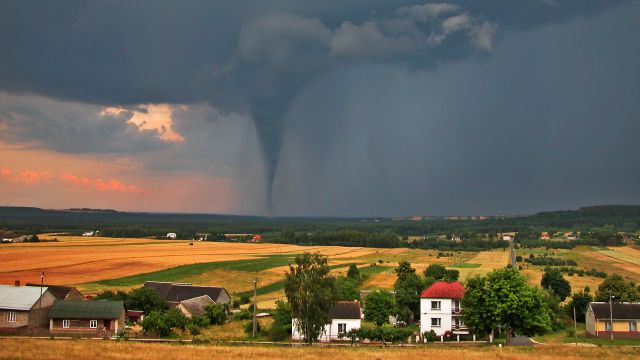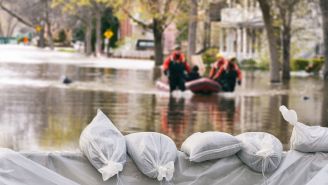While images of tornadoes may be beautiful in photographs, they can be deadly and wreak havoc on residential homes, businesses and natural habitats. Their strong gusts—which can reach up to 250 miles per hour—can tear the roofing off of houses, pavement off of the ground and flip cars and trains; they’re often accompanied by lightning and hail; and they can last anywhere from a few seconds to a few hours.
Unfortunately, “You can't outrun a tornado,” says Matthew Carrick, MD, a trauma surgeon at Medical City Plano in Texas. But there are some ways you can prep and stay safe during these massive wind storms.
How to prepare for a tornado
It’s important to understand the difference between a tornado watch and a tornado warning. “A tornado watch just means conditions are right for a tornado, so be careful,” says Carrick. They often appear as a warning on your cell-phone or as a brief interruption while you’re watching the news. Listen to see if the National Oceanic and Atmospheric Administration (NOAA) has any updates and make sure that you can get to shelter if needed.
A tornado warning, on the other hand, means that a tornado has actually been detected so you should seek shelter as soon as possible.
Here are a few steps to ensure your family is prepared for a tornado:
- Plan ahead and create a family plan for emergency situations. Include where you would go, what you would need and a list of emergency phone numbers.
- Pick a safe space in your house that offers the best protection for your family and pets. A basement, cellar or other lower-level room free of windows is your best bet. If your home doesn’t have a basement, then a bathroom, closet, laundry room or pantry will work. Visit Ready.gov for ways to build a safe room.
- Have an emergency supply kit on hand which includes emergency medications, water, food supplies and batteries for a battery-operated radio or TV. Your supply kit should also include first-aid items, like Band-Aids, in addition to helmets and hard-soled shoes for every family member.
- Know what a tornado looks and sounds like. “The roar is similar to a freight train,” says Carrick. Depending on your geographic location, the sky might have a greenish tint and there may be hail.
- If you live in a tornado warning area and you get an alert, make sure to get to your safe space until you’re in the clear.
Get in, get down and cover up
The most important tip for staying safe during a tornado is to get in, get down and cover up.
- Get in: Get inside and go to the center of your family’s safe space. “Get away from the windows. Go to the middle of the house, where’s there’s the most walls,” suggests Carrick.
- Get down: Get down to the lowest level of your house. Some homes have built-in storm cellars depending on where you live geographically.
- Cover up: Use a blanket, a pillow or a mattress to cover yourself. If the room has a bathtub, get into it and place the mattress over your head. You can also go underneath a table or something sturdy to take cover. To keep your family safe, wear a helmet and strap your child into a car seat if you happen to have one close by.
If you live in a mobile home, there’s only one thing you can really do: “You need to leave that mobile home and seek shelter in a durable, solid building,” says Carrick. Have a designated establishment picked out ahead of time. This is especially important if you live in an area which frequently has tornadoes.
What to do if you’re not at home
Tornadoes can form unexpectedly—and quickly—so knowing how to protect yourself and your family when you’re outside the home is vital.
- In a public space. If you’re at a place of worship, get to a center structural area. “Try to get under the pews and get away from the windows,” says Carrick. If you’re out shopping, stay in the mall storage room or mall restroom while you wait. Again, go somewhere far away from where the windows might blow in and crouch down and cover your head.
- On the road. Most tornado related deaths happen from flying debris and falling trees. The safest place to be is in a shelter, so try to get to one if at all possible.
If you see a tornado or flying debris, pull over to the side of the road and park. Find a low-lying area away from trees. Contrary to what you might think, you want to be in an open area. “Don't seek shelter under an overpass,” says Carrick. Bridges and highway overpasses can be dangerous because they pick up the speed of wind. Keep your seatbelt fastened, duck your head below window level and cover yourself with a cushion or blanket if possible. If you have kids in the car, strap them into their car seat.
What to do post-twister
“If you're trapped in your house, don't try to do too much to get out,” says Carrick. Instead, he suggests lightly tapping on some of the wood, or whatever is trapping you. That way, first responders will hear the tapping and locate you. Moving around broken pieces of wood or furniture could cause it to collapse on you. As long as you’re not stuck, stay put.
“If your house has been blown down and you're safe, you don't want to start searching through your house until one of the authorities has come and cleared it,” says Carrick. Protruding electrical wires could be very dangerous.
Be careful and cognizant of your surroundings. If your home lost power as a result of the tornado, opt to use a flashlight rather than a candle. They’re safer, especially if the conditions are still unknown. If you’re not at home, only head back when authorities say it’s safe to do so.






